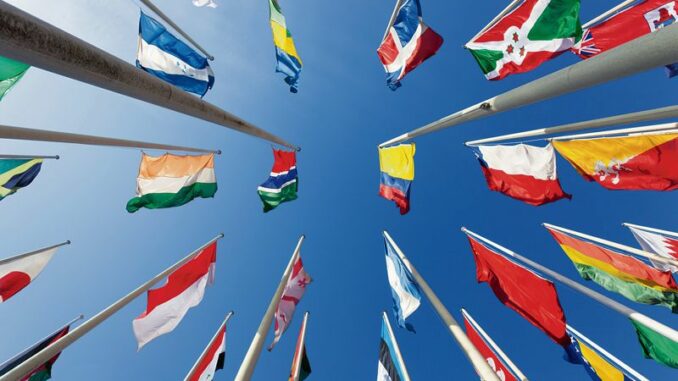
Globalization has bred apprehension among self-appointed custodians of religion that their people are losing faith in old orthodoxies.
“Analysts of early globalization told us that the unimpeded progress of a homogenizing juggernaut of culture would sweep everyone up in a common coil. But the process has also produced an intensified, even irrational, sense of a religious community and hostility towards others who are our fellow citizens, our neighbors, our friends, and our allies. The closing in of the Indian mind has pushed away syncretism and embraced tribalism around totems.”

It is, perhaps, the greatest paradox of our times that the advent of globalization in the 1980s and liberalization/privatization in India in the early 1990s has not been accompanied by the expansion of imagination and cosmopolitanism, but by the closing in of community boundaries. From the 1950s onwards, scholars and statesmen focused on ‘composite’ or ‘syncretic’ culture.
In his 1987 essay, Prof Rasheeduddin Khan, who taught at the Centre for Political Studies, Jawaharlal Nehru University, had written that the Indian civilization was profoundly influenced by the Indo-Aryan stream, which provided the Vedic philosophy, and the Indo-Muslim strand, which was based on the intertwining of the Bhakti Movement and Islamic Sufism. He wrote: “It is not surprising… to realize that the composite culture in India originated in an environment of reconciliation rather than refutation, cooperation rather than confrontation, coexistence rather than mutual annihilation of the politically dominant Islamic strands.”
Khan and other authors, including Aziz Ahmed, did not deny that there was violence between Hindus and Muslims in the medieval period. They creatively drew our attention to the fusion of two cultures in the creative field and in everyday life. The former was manifest in architecture and painting, the latter in shared worship at Sufi shrines and the increasing adoption of Urdu as the language of communication across vast swathes of India.
Since the 1990s, the eruption of ethnic wars across the world and the rise of Hindutva in India have consigned this notion to the margins of history. No one wants to remember the syncretism that the postcolonial generations were brought up on. Religious communities have shut their doors and hatched them down against the Other — now defined as the enemy.
This seems paradoxical in the context of the rapid transmission of the trans-border flow of information, new symbols, new ways of communication and new ways of producing and consuming things. We witness an immediacy to history. It brings wars in Ukraine and the Gaza strip right into our homes. We see the Oscars along with audiences in the west, read the same books, watch the same television series and movies and listen to the same music. Conflict zones in critical sites, as well as celebrations, are as real to us as our own sites of conflict, award ceremonies, sports, reading habits and music. We participate in political protests across the world; we follow the same fashion styles; we adhere to the same canon of aesthetics. There is no refuge, no safe haven against the violence we witness on our television screens.
But globalization, which has produced its own discontent, has also intensified insecurity and anxieties about collective identity. We are back to the early decades of the 19th century, when Raja Ram Mohan Roy asked the question: Who are we? Roy used the wisdom of ancient sacred texts to critique extant practices, such as rituals, superstitions, fasts and belief in false prophets. He initiated a major movement of social reform against Brahmanical domination, gender discrimination and irrational customs.
Today, we see the reinforcement of the same Brahmanical domination in the return of rituals, temple worship, fasts and the entry of saffron-clad ‘godmen’ in politics. The rediscovery of Hinduism in the 19th century brought social reform; the Hindutva campaign of the contemporary era has reinforced orthodoxy amidst globalizations.
Analysts of early globalization told us that the unimpeded progress of a homogenizing juggernaut of culture would sweep everyone up in a common coil. But the process has also produced an intensified, even irrational, sense of a religious community and hostility towards others who are our fellow citizens, our neighbors, our friends, and our allies. The closing in of the Indian mind has pushed away syncretism and embraced tribalism around totems.
Communities are, however, an invention. The hardening of boundaries is a reaction to factors that range from the insecurity that the community’s identity is in danger to the silver tongue of demagogues. This community rejects ‘strangers’. We have lost our syncretic culture and, alongside, we have lost our ability to be human: to suffer the pain of others, to shed tears with them, to rejoice in their victories, to be saddened by their defeats. We have, above all, lost the spirit of tolerance enunciated by Emperor Akbar.
Akbar’s tolerance was described in the memoirs of his son and successor Jahangir: “Followers of various religions had a place in the broad scope of the peerless empire — unlike other countries of the world, like Iran, where there is room for only Shi’ites, and… Turan (Central Asia), where there is room for only Sunnis. Just as all groups and practitioners of all religions have a place within the spacious circle of God’s mercy, in accordance with the dictum that the shadow must follow its source, in my father’s realm, which ended at the salty sea, there was room for the practitioners of various sects and beliefs, both true and imperfect, and strife and altercation were not allowed. Sunni and Shiite worshipped in one mosque and Frank and Jew in one congregation. Utter peaceableness was his established way.” We ignore this message only at our own peril.
Globalization has not spurred cosmopolitanism; it has bred apprehension among self-appointed custodians of religion that their people are losing faith in old orthodoxies, and that the radical project of challenging caste, class and patriarchal hierarchies in a global civil society will strip these ‘defenders of the faith’ of power.
In the process, we have become lesser human beings.
(The author is a Political Scientist)



Be the first to comment